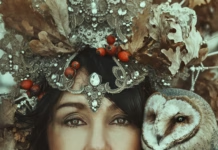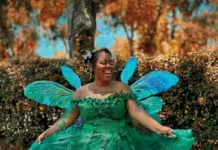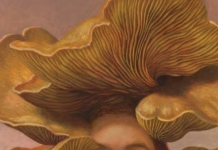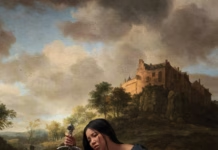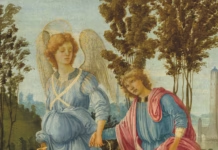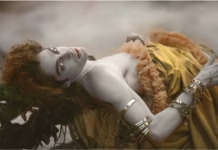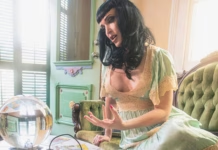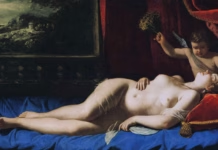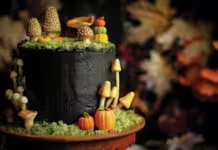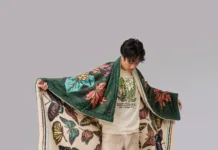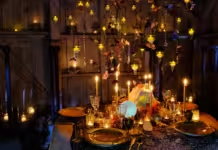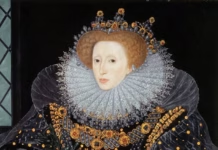They say she was then struck with feverish madness.
If she was, it was an odd sort of madness, for she knew exactly what she needed to do, with an unearthly clarity of mind and steadiness of hand. After Jason left, she ordered the servants to gather plants and herbs that she needed for the project. Working the night away, she wove a resplendent gift for the new bride, a lovely brightly colored gown, with the most intricate of patterns, something to rival the most divine of weavers.
By the break of dawn, the textile had been finished, and a messenger along with her two boys ran swiftly to the new bride with the bright gifts. No one in Medea’s household suspected what was to come…
So goes my telling of the story of Medea in my year-long course on magic and story, Spinning Gold. I tell it from the point of view of the sword she uses for her fateful act, an approach that helps open some avenues of interpretation ordinarily hidden from view. But that lovely gown? Threaded with a deadly flesh-eating poison and just as deadly as the sword if not more so. It’s a story I tell again and again each year to my students and one that never loses its verve, for me or for them.
I’ve long been captivated by the story of Medea, first encountering it in my studies in classics during my college years. The tragedy by Euripides is my primary source material. The story most powerfully represents an injustice that women through the ages have experienced at the hands of men—but all too often have not had the power to amend.
The tale of Medea is one of a woman spurned who also happens to be a witch. And because she is a sorceress of not inconsiderable magic, she refuses to go quietly into the dark night, refuses to be casually cast aside, demurely exit stage left, never to be heard from again. Medea’s heroism is that she refuses to back down in her quest for justice and resorts to the most extreme lengths to right the wrong done to her. And like other heroes of old—Achilles, for example—she goes too far and crosses necessary boundaries, and that crossing teaches us something important about our own humanity and our own power.
All these things were on my mind and in my heart when I stepped into a gallery to view the original painting by Pre-Raphaelite painter Frederick Sandys depicting Medea. His image captures the famous heroine/villainess right after Jason of the Argonauts tells her he’s abandoning her for a younger and richer princess.
I had seen a digital reproduction of the painting, so I had some idea what to expect. But to confront the original, its size and its silent power, was something I was not prepared for.
The most prominent feature of the image is Medea’s physicality: Suspended in time, you can see her fury and her anguish as she tears at the blood-red coral beads strung about her neck. The beads are the brightest color on the canvas, the focal point.
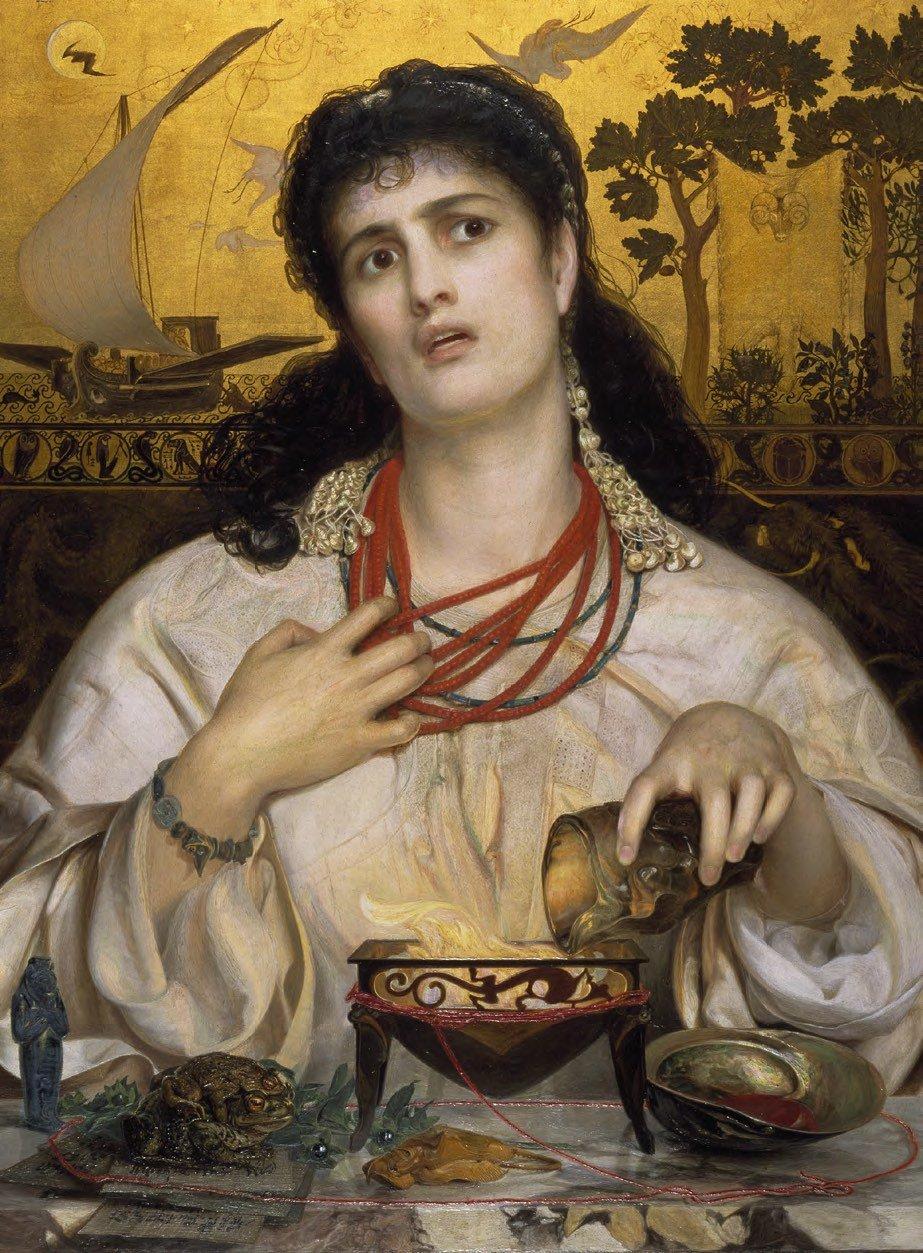
But look closer, and you’ll notice some strange things: A three-eyed frog sits on the table below her! Incense swirls aroundan altar, and to the left sits a little figurine of the Egyptian goddess Bastet. With such things, Sandys calls to mind Medea’s anguished recourse to witchcraft to solve her “Jason problem.”
Standing there in the hushed gallery, I saw many people milling about, and I could almost hear the assumptions exploding, the old categories dissolving like sugar in water. Art could be beautiful and powerful.
As I look at Sandys’s Medea and other paintings as well, I wonder, Why were the Pre-Raphaelites drawn to depict these magical characters? The seers and sorceresses, enchanters and witches?
Practitioners of the sacred and magical arts have, the story goes, always occupied the boundaries. They’re found in the hedgerows where the town and wilder countryside meet. They exist on the margins. They survive on the circumference of the circle, not the center, and they stake their claim to the threshold as opposed to the heart and hearth of the home. This “betwixt and between” vantage point gives the magic makers a unique perspective, as well as particular obligations.
Existing on the edge, in the liminal, they have one foot firmly in the Otherworld and as such are tasked with translation. From the city to the country, from man to animal, from human to divine … or demonic … and back again. The wise woman, witch, mystic, and magician were all looked to and sought out for both the building and the preservation of culture. At the same time they were seen—with their beliefs, odd talismans, and strange actions and associations—as implicit threats to the very cultures and civilizations that they helped build.
There is, of course, another group that falls into the same category and has inherited the same story line: artists. While the witch gazes into her rock crystal, the painter does the same with his palette, the sculptor with a block of marble, clay, or wax. In all cases they’re moving into the imaginal, liminal realm to find something, behold something, and then, piece by piece, bring it back to the world here and now so that it may confer benefit, so that it may bring its medicine forward.
Both magic maker and artist are absolutely essential to growth, refinement, and culture. One will emerge with a spell, a rite, a ceremony. One with a drawing, a painting, a statue, or a poem. Both will be sought after. And then, once their presence starts making others less comfortable, they are asked to return to the village edge; their energy is too hot to handle, their bright moments and dark shadows borrowing from a palette with too many extreme hues.
But every now and then you get a Medea: the witch who is not going to return to the edges of vision until her services are needed once more. Every now and then you get a Circe or a Morgana Le Fey. They refuse to exit stage left, refuse to have their stories muted or muzzled. Rather they stay stubbornly in the center; they crop up like mushrooms after storms in art and story, poetry and liturgy; they cheat death and somehow remain utterly alive in the imaginations of generation after generation. Perhaps this is the ultimate magic. These rare cases remind the world at large that no box is big enough, no forest edge wide enough to contain their essence. They break rules, command armies, show humans their deepest desires and secrets and usually cause a great deal of general mayhem. Something about their characters and stories rings true on a belly-deep level for us. As I wrote in my book Making Magic, once we start looking we will find the footprints of magic tracking up and down across our lives and our stories; magic never really did keep itself to the edges.
So in this way a Pre-Raphaelite painter such as Sandys found an affinity in a figure such as Medea. He was among a group of artists and artisans who refused to occupy only the edges or buy into the overly rigid hierarchies of their day that determined in large part what did and did not constitute art. Like the magical women whose stories they told with pen and paper, paint and brush, the Pre-Raphaelites were radical in the truest sense of the world—they were returning to the roots of things.
Nature and creating authentic works became hallmark elements in their work, but they went further and broader than that, claiming that art of all kinds, from painting to design to jewelry making, could and should be seen not in the categories of an artificial hierarchy but rather as a unified whole—a jewel with many facets. These artisans reached back to ancient sources such as the Greek myths and Arthurian ballads, and from them they highlighted the numinous, liminal, and magical. The witch especially, in their hands, ceased to be the expected hideous crone and instead had her beauty, allure, sexuality, and, perhaps most important of all, mystical power fully expressed. No longer found on the margins, these magical women were their spokeswomen, their muses, and so were placed front and center. I find that it is a position we have never really retreated from and, if anything, are now staking a stronger claim to than ever before.
Witches had good stories to tell as well as bad, and magic might, just might, be more real than we think. This is one part of the legacy the Pre-Raphaelites bequeathed to us. No, I don’t see the witches and magic makers and artists going back to their unseen glades. I see them at the center of towns and cities—making plans, raising children, supporting causes that matter, and usually, most of the time, holding hands with an artist. The Pre-Raphaelites did not make this possible, but they invited us to see that it was possible, which may be an even greater achievement. Our world has been made not only richer but more magical by their efforts. And we, especially we who love magic, owe them our deepest gratitude.





